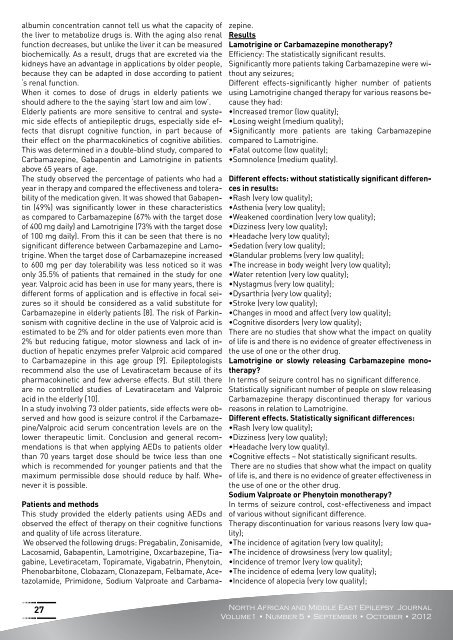In partnership with : - CHU - Marrakech
In partnership with : - CHU - Marrakech
In partnership with : - CHU - Marrakech
You also want an ePaper? Increase the reach of your titles
YUMPU automatically turns print PDFs into web optimized ePapers that Google loves.
albumin concentration cannot tell us what the capacity of<br />
the liver to metabolize drugs is. With the aging also renal<br />
function decreases, but unlike the liver it can be measured<br />
biochemically. As a result, drugs that are excreted via the<br />
kidneys have an advantage in applications by older people,<br />
because they can be adapted in dose according to patient<br />
‘s renal function.<br />
When it comes to dose of drugs in elderly patients we<br />
should adhere to the the saying ‘start low and aim low’.<br />
Elderly patients are more sensitive to central and systemic<br />
side effects of antiepileptic drugs, especially side effects<br />
that disrupt cognitive function, in part because of<br />
their effect on the pharmacokinetics of cognitive abilities.<br />
This was determined in a double-blind study, compared to<br />
Carbamazepine, Gabapentin and Lamotrigine in patients<br />
above 65 years of age.<br />
The study observed the percentage of patients who had a<br />
year in therapy and compared the effectiveness and tolerability<br />
of the medication given. It was showed that Gabapentin<br />
(49%) was significantly lower in these characteristics<br />
as compared to Carbamazepine (67% <strong>with</strong> the target dose<br />
of 400 mg daily) and Lamotrigine (73% <strong>with</strong> the target dose<br />
of 100 mg daily). From this it can be seen that there is no<br />
significant difference between Carbamazepine and Lamotrigine.<br />
When the target dose of Carbamazepine increased<br />
to 600 mg per day tolerability was less noticed so it was<br />
only 35.5% of patients that remained in the study for one<br />
year. Valproic acid has been in use for many years, there is<br />
different forms of application and is effective in focal seizures<br />
so it should be considered as a valid substitute for<br />
Carbamazepine in elderly patients [8]. The risk of Parkinsonism<br />
<strong>with</strong> cognitive decline in the use of Valproic acid is<br />
estimated to be 2% and for older patients even more than<br />
2% but reducing fatigue, motor slowness and lack of induction<br />
of hepatic enzymes prefer Valproic acid compared<br />
to Carbamazepine in this age group [9]. Epileptologists<br />
recommend also the use of Levatiracetam because of its<br />
pharmacokinetic and few adverse effects. But still there<br />
are no controlled studies of Levatiracetam and Valproic<br />
acid in the elderly [10].<br />
<strong>In</strong> a study involving 73 older patients, side effects were observed<br />
and how good is seizure control if the Carbamazepine/Valproic<br />
acid serum concentration levels are on the<br />
lower therapeutic limit. Conclusion and general recommendations<br />
is that when applying AEDs to patients older<br />
than 70 years target dose should be twice less than one<br />
which is recommended for younger patients and that the<br />
maximum permissible dose should reduce by half. Whenever<br />
it is possible.<br />
Patients and methods<br />
This study provided the elderly patients using AEDs and<br />
observed the effect of therapy on their cognitive functions<br />
and quality of life across literature.<br />
We observed the following drugs: Pregabalin, Zonisamide,<br />
Lacosamid, Gabapentin, Lamotrigine, Oxcarbazepine, Tiagabine,<br />
Levetiracetam, Topiramate, Vigabatrin, Phenytoin,<br />
Phenobarbitone, Clobazam, Clonazepam, Felbamate, Acetazolamide,<br />
Primidone, Sodium Valproate and Carbama-<br />
27<br />
zepine.<br />
Results<br />
Lamotrigine or Carbamazepine monotherapy?<br />
Efficiency: The statistically significant results.<br />
Significantly more patients taking Carbamazepine were <strong>with</strong>out<br />
any seizures;<br />
Different effects-significantly higher number of patients<br />
using Lamotrigine changed therapy for various reasons because<br />
they had:<br />
•<strong>In</strong>creased tremor (low quality);<br />
•Losing weight (medium quality);<br />
•Significantly more patients are taking Carbamazepine<br />
compared to Lamotrigine.<br />
•Fatal outcome (low quality);<br />
•Somnolence (medium quality).<br />
Different effects: <strong>with</strong>out statistically significant differences<br />
in results:<br />
•Rash (very low quality);<br />
•Asthenia (very low quality);<br />
•Weakened coordination (very low quality);<br />
•Dizziness (very low quality);<br />
•Headache (very low quality);<br />
•Sedation (very low quality);<br />
•Glandular problems (very low quality);<br />
•The increase in body weight (very low quality);<br />
•Water retention (very low quality);<br />
•Nystagmus (very low quality);<br />
•Dysarthria (very low quality);<br />
•Stroke (very low quality);<br />
•Changes in mood and affect (very low quality);<br />
•Cognitive disorders (very low quality);<br />
There are no studies that show what the impact on quality<br />
of life is and there is no evidence of greater effectiveness in<br />
the use of one or the other drug.<br />
Lamotrigine or slowly releasing Carbamazepine monotherapy?<br />
<strong>In</strong> terms of seizure control has no significant difference.<br />
Statistically significant number of people on slow releasing<br />
Carbamazepine therapy discontinued therapy for various<br />
reasons in relation to Lamotrigine.<br />
Different effects. Statistically significant differences:<br />
•Rash (very low quality);<br />
•Dizziness (very low quality);<br />
•Headache (very low quality).<br />
•Cognitive effects – Not statistically significant results.<br />
There are no studies that show what the impact on quality<br />
of life is, and there is no evidence of greater effectiveness in<br />
the use of one or the other drug.<br />
Sodium Valproate or Phenytoin monotherapy?<br />
<strong>In</strong> terms of seizure control, cost-effectiveness and impact<br />
of various <strong>with</strong>out significant difference.<br />
Therapy discontinuation for various reasons (very low quality);<br />
•The incidence of agitation (very low quality);<br />
•The incidence of drowsiness (very low quality);<br />
•<strong>In</strong>cidence of tremor (very low quality);<br />
•The incidence of edema (very low quality);<br />
•<strong>In</strong>cidence of alopecia (very low quality);<br />
North African and Middle East Epilepsy Journal<br />
Volume1 • Number 5 • September • October • 2012


